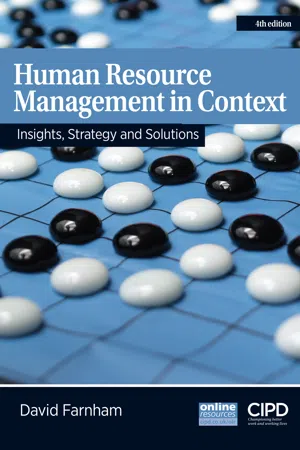1.1INTRODUCTION
This chapter provides the theoretical and practical backgrounds to the rest of the book. It does this by giving an outline description, analysis and overview of contemporary human resource management (HRM) within the United Kingdom (UK) and the external contexts driving it. These contexts are identified within the framework of the insights, strategy and solutions professional area of the CIPD Profession Map (CIPD 2012). HRM, loosely defined as the managing of people at work, has undergone significant changes in its purposes, structures and activities in recent years. This chapter starts by examining the factors influencing these developments and considers the changing nature of HRM and how it has developed historically. The chapter then identifies and discusses some key issues on the HRM agenda. These include: how the human resources (HR) function is organised, HR and performance, line managers and HR, outsourcing HR, HRM and ethics, and HR strategy. Next, the chapter summarises the major institutional, external contexts impacting on the HR function that influence HR strategy and practices; issues that are revisited in greater depth later in the book. Finally, the chapter puts these developments into a global context by discussing some trends in international HRM.
1.2DEFINING AND UNDERSTANDING CONTEMPORARY HRM
Providing a definitive definition of contemporary HRM is problematic. This is because there is no generally agreed framework for understanding and analysing the HR function; there are only competing models. In practice, the HR function within organisations in the UK (and elsewhere) is infinitely flexible, organisationally contingent over time and driven principally by the external contexts of the age; and these often change within short periods of time. Indeed, the history of HR in the UK and elsewhere shows that it has had to change its priorities and focus its activities by reinventing itself continuously. This has been largely in response to external socio-economic factors beyond the immediate control of HR practitioners or senior managers. For these reasons a variety of definitions, frameworks and models can be found in any of the basic (or not so basic) texts and in the wide range of articles examining and exploring the functions, roles and antecedents of contemporary HRM in organisations. However, some understanding of the differing frameworks and intellectual underpinnings of HRM is necessary, if readers are to identify, understand and analyse the major external and internal contexts within which HR professionals operate today. It is these dynamic contexts which provide a continuing theme throughout the text.
One major text in the field, Marchington et al (2012), defines HRM curtly as the management of employment. Another standard text provides no agreed definition of HRM but distinguishes between ‘soft’ and ‘hard’ versions of it. These writers, drawing upon Guest (1987) and Storey (1992), claim soft HRM ‘recognises employees as a resource worth investing in, and tends to focus on high commitment/high involvement human resource practices’. Hard HRM ‘identifies employees as a cost to be minimised, and tends to focus on “flexibility techniques” and limited investment in learning and development’ (Beardwell and Claydon 2007, pp671, 675). Boxall and Purcell (2011) regard HRM in the English-speaking world as all those activities associated with the management of employment relationships in the firm.
1.2.1 FROM PERSONNEL MANAGEMENT TO HRM
For Torrington et al (2008, p6), the term HRM is used in two ways. They provide a useful distinction between ‘HRM mark 1’ and ‘HRM mark 2’. The first is a generic term used to describe the body of management activities which have been traditionally labelled ‘personnel management’. The second is regarded as a distinctive approach to HRM and suggests a specific philosophy towards carrying out ‘people-oriented organisational activities’. Generic HRM seeks to achieve four key objectives: staffing, performance, change-management and administration. These organisational objectives are delivered primarily by personnel/HR specialists or personnel/HR generalists. HRM as a distinctive approach to managing people delivers organisational objectives by HR professionals in collaboration with line managers.
Guest (1987), in turn, has identified a number of ‘stereotypical’ features distinguishing the personnel management tradition (HRM mark 1) from the distinctive HR tradition (HRM mark 2). Personnel management is specialist and professionally driven. Its features include: a short-term, ad hoc time perspective; a pluralist, collective approach to managing employment relations; bureaucratic, centralised, organisational structures; and cost minimisation evaluation criteria. The distinctive, ‘new’ HR tradition (HRM mark 2) is largely integrated with line management. Its features include: a long-term, strategic time perspective; a unitary, individual approach to managing employment relations; more organic, devolved, flexible organisational structures; and maximum utilisation of human resources.
Interestingly, Torrington et al identify six main periods or ‘themes’ in the history of personnel management and its transition into contemporary HRM. Indeed, as Gennard and Kelly (1997, p31) have perceptively observed, delivery of the personnel/HR function has always been flexible and has adjusted its dominant values historically ‘as macro circumstances change’. Legge (1995, pxiv) argues, however, that the apparent overshadowing of personnel management by the distinctive HRM tradition lies in its function as ‘a rhetoric about how employees should be managed to achieve competitive advantage [rather] than as a coherent new practice’. Keenoy (1990) goes further in his critique of the new HRM, viewing it as ‘a wolf in sheep’s clothing’. For him, HRM is more rhetoric than reality and simply supports ideological shifts in the employment relationship, driven by market pressures.
Torrington et al (2008) describe the first theme in the evolution of personnel management and HRM in the UK as ‘social justice’. This originated on a limited scale amongst a few enlightened employers in nineteenth-century Britain. These employers promoted a welfare approach to managing people by attempting to ameliorate working conditions and avoid adversarial industrial relations. Second, in the first half of the twentieth century, ‘humane bureaucracy’, influenced by managerial practitioners and observers such as Taylor (1911), Fayol (1916) and Mayo (1933) came to the fore in management practices. Taylor’s ‘scientific management’ principles adopted a work study, incentive-based approach to managing people. This was followed by the ‘human relations’ school, originating in Mayo’s works reported in the Hawthorne experiments, and later others, which aimed at fostering good ‘human relations’, high morale and efficiency at work. Third, in response to strong trade unions in the 1960s, a period of ‘negotiated consent’ was fostered by personnel and industrial relations managers. This aimed at containing union power and managing workers by representative systems and collective agreements. Fourth, from the late 1960s, the focus was on ‘organisation’ provided by personnel specialists. They did this by developing career paths, opportunities for personal growth and workforce planning. Fifth, the recent ‘HRM’ theme, with its focus on performance management, planning, monitoring and control, flexibility and employees as individuals, emerged and grew in the English-speaking world throughout the 1980s, 1990s and 2000s. This was in response to what is loosely described as globalisation and neo-liberal economic policies.
A sixth theme claimed by some observers, such as Bach (2005, pp28–9), is a ‘new HR’. Driven by employer demands for competitive advantage, this theme is characterised by a ‘new trajectory’ in response to significant long-term trends in the business context. These include a global perspective, issues of legal compliance, the emergence of ‘multi-employer’ networks (or ‘permeable organisations’), engagement of individual employees emotionally at work, and a customer-centred focus in business. This trend or theme seems to reflect a shift away from the ‘management of jobs’ by organisations to the ‘management of people’ within them (Lepak and Snell 2007).
In their summary review of the HR literature, Beardwell and Clark (2007) identify five comparative models of personnel management and HRM. They describe these as: the planning perspective, people management perspective, employment relations perspective, structure/systems perspective, and role perspective. In each case, practices and theories of managing people within each of the personnel management and HRM traditions differ. In outline, personnel management in the planning perspective is reactive and marginal to corporate plans. In the people management perspective, people are a variable cost, subject to compliance and organisational control. In the employment relations perspective, personnel management accepts that self-interest dominates at work and that conflicts of interests among stakeholders are inevitable. Personnel management in the structure/systems perspective imposes control of staff from the top and control of information flows downwards. In the role perspec...

